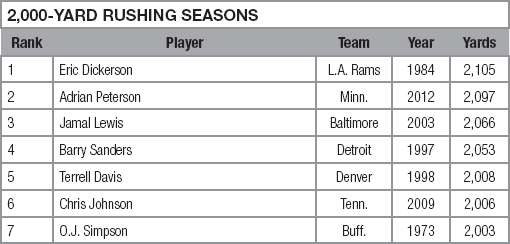
#46
O. J. SIMPSON
It was a lifetime ago. Or two lifetimes ago. Long before O. J. Simpson became a pivotal figure in America’s debate over race relations and was accused of the double murder of his ex-wife and her friend, there was a time when O. J. Simpson was perhaps the best football player in the world. After a Heisman Trophy–winning career at USC, a world-class smile and a bevy of highlight-film runs, the Buffalo Bills made Heisman Trophy winner O. J. Simpson the first overall pick in the 1969 NFL draft.
Simpson would go on to become a record-breaking runner in the NFL, but not before some difficulties in his early years. For one, Buffalo head coach John Rauch was hesitant to let Simpson take over as the team’s featured back in his offense. It was a frustrating time for Simpson, who looked like an average back in the Buffalo scheme.
But pro football fans finally saw what Simpson was capable of when Lou Saban took over as head coach in 1972. Buffalo owner Ralph Wilson had been tired of the way coaches had kept the wraps on Simpson. He told Saban to let Simpson run.
When Saban met with Simpson, he told him that he was planning to let the running back run the way he had when he was at the University of Southern California. Simpson became the happiest man in western New York after that conversation and his subsequent running helped the Bills become a viable force in the NFL. The 1972 season was Simpson’s coming-out party. After looking over his shoulder for the first three years of his career as if waiting to be taken out of the game, Simpson started to run free and easy for the first time since he had been a dominating college star. “The Juice” ran for a league-high 1,251 yards in 1972 while averaging a respectable 4.3 yards per carry. He had six rushing touchdowns, including a shocking 94-yarder that would prove to be the long play of his career.
Simpson liked his role in the Saban offense and promised Buffalo fans that what they had seen was just the beginning of what he would accomplish throughout his career. Simpson knew he was on the verge of accomplishing some memorable feats with the great offensive line built by Saban with Hall of Famer Joe Delammielure and Reggie McKenzie, a unit dubbed “The Electric Company” because “it turned on the Juice.”
Simpson went from star to legend the next season. The NFL was still playing a 14-game schedule in 1973, yet Simpson carried 332 times for 2,003 yards and 12 touchdowns, capturing league MVP honors. He averaged 6.0 yards per carry and was simply too fast and quick for defenses trying to slow him down. He became the first player to rush for 2,000 yards in an NFL season and would hold the record for most rushing yards in a season until Eric Dickerson ran for 2,105 yards 11 years later.
Simpson took great pride in his accomplishment. “No matter what happens to me, I was the first man to rush for 2,000 yards in a season,” Simpson said. “They can never take that away from me.” Simpson was the only player to rush for 2,000 yards in a 14-game season.
He needed two spectacular games at the end of the season to reach the mark. In Week 13, Simpson carried 22 times for 219 yards against the New England Patriots in a 37–13 Buffalo victory. The following week, he carried 34 times for 200 yards in the snow at Shea Stadium against the New York Jets in a 34–14 Buffalo victory.
Two years later—another 14-game season—Simpson was nearly as good. He carried 329 times for 1,817 yards with 16 touchdowns and averaged 5.5 yards per carry. He also scored seven more touchdowns as a receiver, setting an NFL record for touchdowns in a season. He followed that season with 1,503 yards in 1976, averaging 5.2 yards per carry and rushing for eight touchdowns.
Over a five-year period from 1972 through 1976, Simpson averaged 1,540 yards per season and led the league in rushing four times. He also averaged nine touchdowns per season over that span. It was a sensational five-year run, nearly as good as LaDainian Tomlinson would post three decades later. Injuries would later take their toll on the six-time Pro Bowler, however, and he had little left in the tank when he finished his career with the San Francisco 49ers in 1978 and 1979.
After his career ended, Simpson made movies and served as an analyst on NFL broadcasts. The word that was used to describe his personality was “affable.”
That would all change in June 1994 with the double murder of Nicole Brown and Ronald Goldman. Though he was acquitted of the murders, Simpson’s momentous achievements on the field were replaced in the collective American memory by what was perceived to be his monstrous activity off of it.